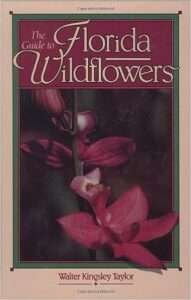
Blue Native Flowers Common to Central Florida
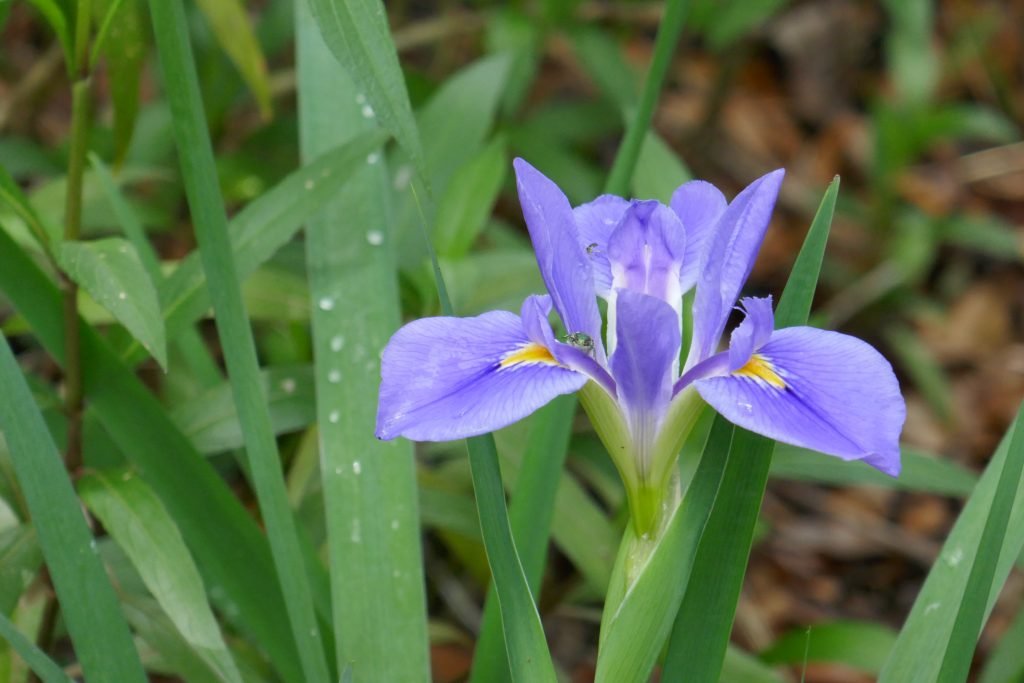
Commelina erecta
(Whitemouth Dayflower)

Latin Name: Commelina erecta
Common Names: whitemouth dayflower
Family: It is in the Commelinaceae, or spiderwort, family.
Form: Whitemouth dayflower is a a perennial wildflower that grows as a groundcover and can reach 2 feet in height.
Leaves: The leaves are alternate and lanceolate or elliptic in shape with entire margins. They have a succulent appearance.
Flowers: The blue flowers appear in late winter, spring, summer and fall.
Habitat: Whitemouth dayflower grows in sandhills, scrub and disturbed sites.
Native Range: AL, AR, AZ, CO, DC, DE, FL, GA, IA, IL, IN, KS, KY, LA, MD, MI, MN, MO, MS, NC, NE, NJ, NM, NY, OK, PA, RI, SC, SD, TN, TX, VA, WI, WV, and WY.
Landscape Use: In the home landscape it grows in full sun to part shade with average to dry moisture. It tends to sprawl and form areas of a thin ground cover in dry areas. It can be kept more lush by frequent watering and occasional feedings.
Wildlife Uses: The flowers are a source of nectar for many small insects. The seeds and vegetation are eaten by songbirds.
Propagation: Can be grown from seed, but runners can be transplanted very easily and are the best way to propagate it.
Conoclinium coelestinum
(Blue Mistflower)
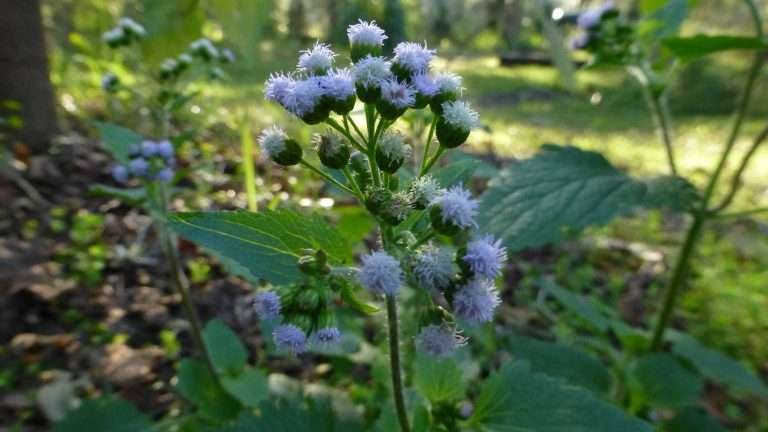
Latin Name: Conoclinium coelestinum
Common Names: Blue mistflower, wild ageratum, and blue boneset.
Family: It is found in the Asteraceae, or aster, Family.
Form: It is a wildflower that grows to a height of approximately 3 feet.
Leaves: Blue mistflower leaves are stalked and opposite on the stems. Margins are toothed. They are ovate to almost triangular in shape with a wrinkled texture and 3 veins.
Flowers: The blue flowers appear in the summer and fall.
Habitat: It occurs naturally in moist meadows, roadsides, woodland borders, riparian areas, and wet woodlands.
Native Range: It is native to the following states: AL, AR, DC, DE, FL, GA, IL, IN, KS, KY, LA, MD, MI, MO, MS, NC, NE, NJ, NY, OH, OK, PA, SC, TN, TX, VA, and WV.
Landscape Use: In the home landscape it grows in full sun to part shade. It looks best en mass in a natural setting because the flowers are small. It can be grown in containers as well.
Wildlife Uses: The flowers are a nectar source for many small insects.
Propagation: Propagation is achieved by growing it from seed or transplants. Rather large plants will transplant well if kept very moist and the flowers removed.
Eryngium baldwinii
(Blue Eryngo)

Latin Name: Eryngium baldwinii
Common Names: Blue Eryngo
Family: It is found in the Apiaceae, or carrot, family.
Form: It is a wildflower that grows to about a foot in height and prostrate as a ground cover.
Leaves: The leaves are alternate with toothed margins and are elliptic to elliptic- ovate in shape.
Flowers: The blue flowers appear all year.
Habitat: It occurs naturally in moist meadows, roadsides, woodland borders, riparian areas, and wet woodlands.
Native Range: It is native to Florida and Georgia.
Landscape Use: In the home landscape it grows in full sun to part shade. It looks best allowed to spread out as a ground cover because the flowers are very small.
Wildlife Uses: The flowers are a nectar source for many small insects and squirrels and songbirds eat the flowers and seeds.
Propagation: Propagation is achieved by growing it from seed or transplants. Any piece of the plant that has roots can be transplanted to a moist site.
Hydrolea corymbosa
(Skyflower)
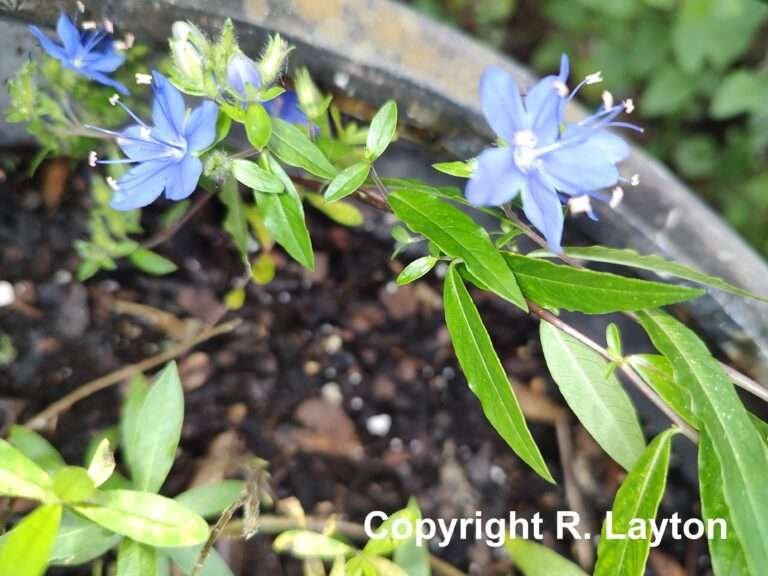
Latin Name: Hydrolea corymbosa
Common Names: Skyflower and Tall Hydrolea.
Family: It is in the Hydroleaceae, or waterpod, family.
Form: A perennial, wildflower, that grows to a height of about two feet.
Leaves: The leaves are alternate and stalked. They are elliptic to lanceolate in shape with entire margins and narrow tips.
Flowers: The bright blue flowers appear in the summer and fall.
Habitat: It occurs naturally in swamp, marshes, ponds & lake margins, damp forested areas, and roadside ditches that stay relatively moist.
Native Range: It is native to the following states: Alabama, Florida, Georgia, and South Carolina.
Landscape Use: In the home landscape it can be planted in moist sites and full sun for the best blooming. Too much shade and it won’t flower very well, and will most likely move itself to the sun if it’s near the area where the original was planted.
Wildlife Uses: It is a favorite nectar source for bees.
Propagation: It can be grown from seeds, cuttings and transplants. It spreads naturally by rhizomes.
Ipomoea indica
(Oceanblue Morning-glory)
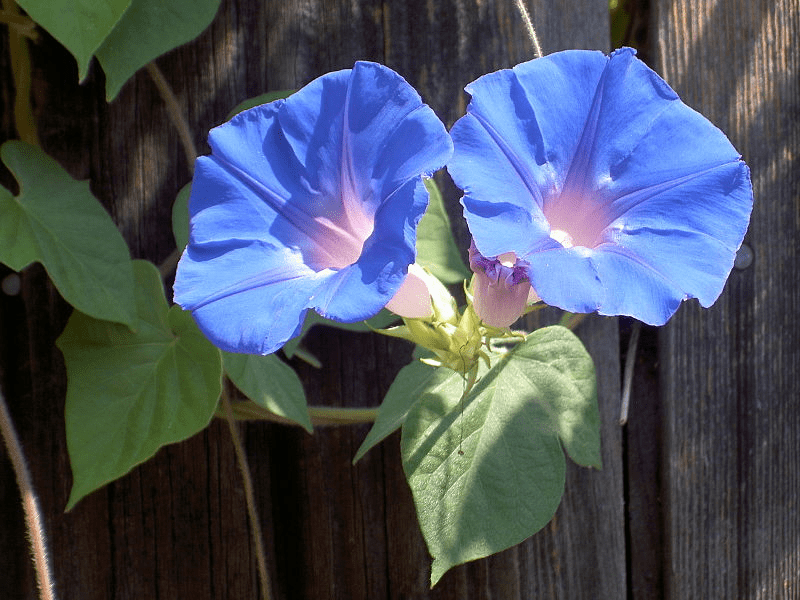
Latin Name: Ipomoea indica
Common Names: Oceanblue morning glory and blue morning glory.
Family: It is in the Convolvulaceae, or morning glory, family.
Form: It is an annual vine that grows to a length of about ten feet.
Leaves: The leaves are alternate, about 10 cm in length, and may be lobed or entire.
Flowers: The flowers are trumpet shaped and can vary in color from pink to blue.
Habitat: It occurs naturally in forests, thickets, fence rows, and disturbed sites.
Landscape Use: It can be grown in full sun with average moisture. It can be allowed to climb over existing vegetation.
Native Range: It can be found growing throughout the entire state.
Wildlife Use: The flowers are a source of nectar for many pollinators and the seeds are eaten by songbirds. If the vegetation is dense enough birds may use it for nesting.
Propagation: Generally grown from seed, but can be transplanted when very young.
Note: I have to say I’m more than confused about this morning glory’s native status because some sites list it as native and some list it as introduced. I’m going with the USF Herbarium site saying it’s native.
Iris virginica
(Blue Flag Iris)

Latin Name: Iris virginica
Common Names: Blue flag iris, Southern blue flag and Virginia iris.
Family: It is found in the Iridaceae, iris, family.
Form: It is a perennial that grows in clumps and spreads out by rhizomes. It grows to about 3 feet in height.
Leaves: Its leaves are long sword shaped emerging from the base of the plant. The leaf edges are entire.
Flowers: The flowers have three large hooded petals.
Habitat: It grows in swamps, wet prairies, marshes, and roadside ditches.
Landscape Use: In the home landscape it can be grown in moist sites, but not standing water. It flowers best if planted in full sun.
Native Range: It is native to the following states: AL, AR, DC, FL, GA, IA, IL, IN, KS, KY, LA, MD, MI, MN, MO, MS, NC, NE, NJ, NY, OH, OK, PA, SC, TN, TX, VA, WI, and WV.
Wildlife Use: The flowers are pollinated mostly by beetles and large bees.
Propagation: It can be grown easily from seed, but it takes three years before it will begin blooming so most people choose to buy plants or transplant rhizomes.
Lupinus diffusus
(Skyblue Lupine)
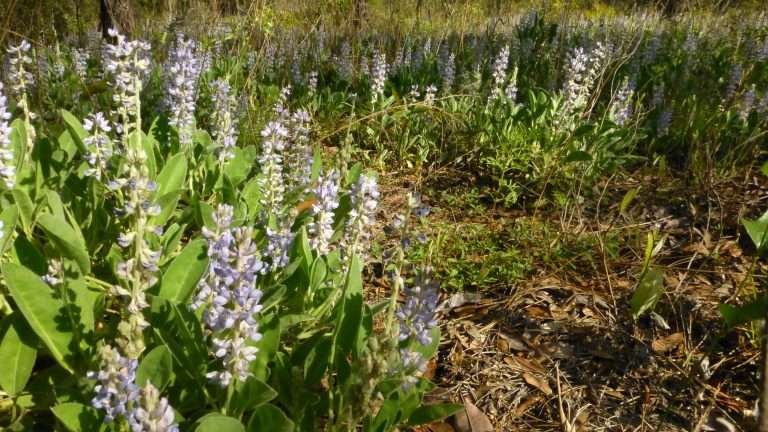
Latin Name: Lupinus diffusus
Common Names: Oak ridge lupine, skyblue lupine, and spreading lupine.
Family: It is found in the Fabaceae, or bean, family.
Form: A perennial wildflower that grows in clumps and when in bloom may reach a height of around three feet.
Leaves: The leaves are thick and velvety. They are stalked, have entire margins, and are ovate to elliptic in shape.
Flowers: The flowers appear in the late winter and early spring. They are sky blue in color and pea flower shaped.
Habitat: It grows in sandhills, pinelands, scrub, and dry forests in open areas of the canopy.
Landscape Use: It is not a good candidate for home landscape use because it is notoriously difficult to start from seed (it needs to be direct sown) and needs a specific type of habitat to thrive.
Native Range: It is native to the following states: AL, FL, GA, MS, NC, and SC.
Wildlife Use: The flowers attract pollinators such as butterflies, bees, beetles and wasps.
The seeds are eaten by songbirds and gamebirds.
It is the larval food for the genista broom moth (Uresiphita reversalis).
Propagation: It is best to purchase from a native nursery, but even then if the roots are too disturbed during planting the plant will not survive.
It can be grown from seed if sown directly in the ground, but it is notoriously difficult.
Salvia azurea
(Azure Blue Sage)
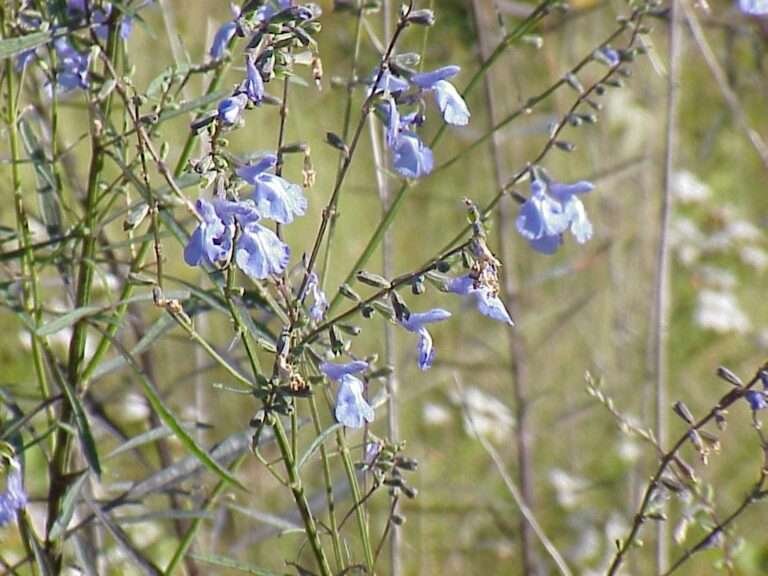
Latin Name: Salvia azurea
Common Names: Pitcher sage, big blue sage, azure sage, giant blue sage, and blue sage.
Family: It is in the Lamiaceae, or mint, family.
Form: A perennial wildflower that grows to a height of about three feet.
Leaves: The leaves are opposite and may be toothed or entire. Basal leaves are absent and the upper leaves are linear to lanceolate.
Flowers: The flowers are about 2 cm in length with a large lower petal and short upper petal. The lower petal is two toothed. The flowers grow on spikelike clusters.
Habitat: It grows in flatwoods, sandhills, open pinelands, and dry forests.
Native Range: It is native to the following states: AL, AR, CO, CT, FL, GA, IA, IL, IN, KS, KY, LA, MI, MO, MS, NC, NE, NM, NY, OH, OK, SC, TN, TX, UT, and WI.
Landscape Use: In the home landscape it can be grown in dry sites that have a good deal of sand and not a lot of leaf litter.
Wildlife Uses: The flowers are a source of nectar for many pollinators including butterflies, bees, wasps and beetles. The seeds are eaten by small songbirds and squirrels.
Propagation: It is best propagated by seed, but small specimens may be transplanted with success.
Salvia lyrata
(Lyre-leaf Sage)

Latin Name: Salvia lyrata
Common Names:
Family: It is in the Laminaceae, or mint, family.
Form: A perennial wildflower that grows to a height of about 18 inches when in bloom.
Leaves: Most of the leaves appear in a rosette at the base of the plant at ground level and can grow to a length of about eight inches. The leaves are a dark green with some having maroon splotches through the center. The margins of the leaves may be toothed, entire or lobed.
Flowers: The flowers are pale blue and appear in late winter and early spring at the top of a tall stalk, which can reach 24 inches in height.
Habitat: Open forests, fields and disturbed areas such as roadsides.
Native Range: It is native to the following states AL, AR, CT, DC, DE, FL, GA, IL, IN, KS, KY, LA, MD, MO, MS, NC, NJ, NY, OH, OK, PA, SC, TN, TX, VA, and WV.
Landscape Use: In the home landscape it grows in part-shade to full sun with average moisture. The individuals of this native wildflower are not that impressive, but in mass they are beautiful. It can be grown in the shade of large oak trees and in spots where grass won’t grow.
Wildlife Uses: It is a fantastic source of nectar for butterflies and bees in late winter when little else is blooming. Migratory birds such as gold finches use it as a source of food in the winter as do gray squirrels.
Propagation: Can be started by seed, and also transplants very well.
Salvia misella
(River Sage)

Latin Name: Salvia misella
Common Names: River sage, Florida Keys sage, and Southern river sage.
Family: It is in the Laminaceae, or mint, family.
Form: A delicate, perennial wildflower that grows to about a foot in height and spreads out to make a type of groundcover.
Leaves: Opposite and stalked with toothed margins and ovate shape. Leaf blades extend slightly onto the petioles.
Flowers: Tiny blue flowers appear in the spring, summer and fall.
Habitat: Forests, stream banks, moist areas with good sunlight.
Native Range: It is native to Florida.
Landscape Use: In the home landscape it grows in part-shade to full sun with moist soils, but not standing water. Any spot that gets a little extra moisture will allow this plant a place in your green space.
Wildlife Uses: Small butterflies and bees use the flowers as a nectar source. Birds and squirrels will eat the seeds.
Propagation: It is easily propagated from seed and also transplants very easily. One small piece with any rootlets will grow if kept moist.
Scutellaria arenicola
(Florida Scrub Skullcap)
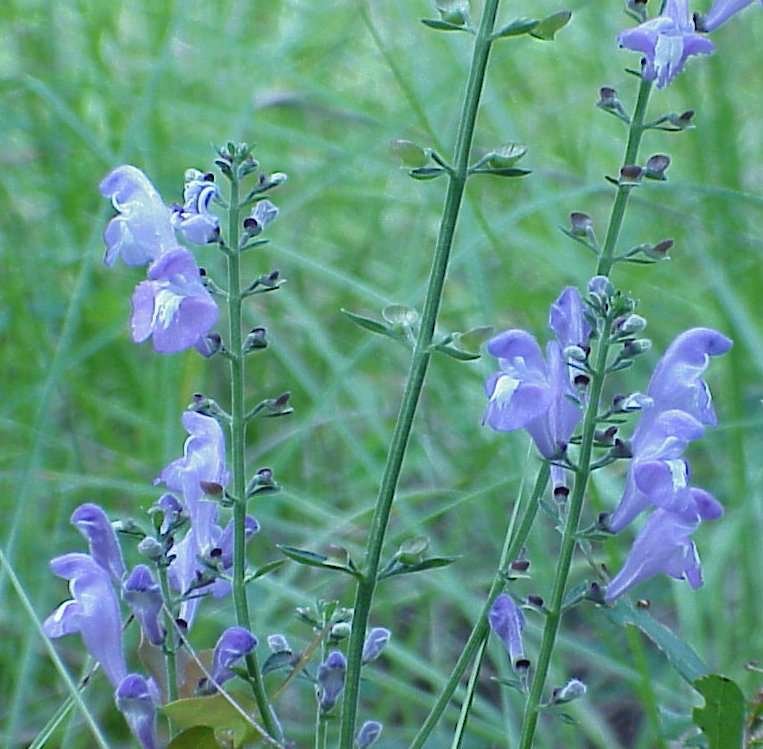
Latin Name: Scutellaria arenicola
Common Names: Florida scrub skullcap)
Family: It is in the Laminaceae, or mint, family.
Form: A delicate, perennial wildflower that grows to about three feet in height.
Leaves: The leaves are opposite and may be stalked or sessile. Basal leaves are elliptic and toothed.
Flowers: The blue flowers appear in the spring and summer.
Habitat: It occurs naturally in pinelands and sandhills.
Native Range: It is found in the following states: Florida and Georgia.
Landscape Use: In the home landscape it can be grown in partial shade with dry to average moisture.
Wildlife Uses: It is a favorite nectar source for bees.
Propagation: It is easily propagated from seed and also transplants when very small.
Sisyrinchium angustifolium
(Narrowleaf Blue-eyed Grass)

Latin Name: Sisyrinchium angustifolium
Common Names: Narrow leaf blue-eyed grass and Bermuda blue-eyed grass.
Family: It is found in the Iridaceae, or iris, family.
Form: A perennial wildflower that grows to about a foot in height. It forms small clumps and looks like grass when not in bloom.
Leaves: The leaves are narrow grasslike with entire margins. They are narrow and no wider than 4mm.
Flowers: The brilliant blue flowers are star shaped and appear in the spring and summer.
Habitat: It occurs naturally in moist forests, wet fields and pastures, and along stream banks.
Native Range: It is native to the following states: AL, AR, CT, DC, DE, FL, GA, IA, IL, IN, KS, KY, LA, MA, MD, ME, MI, MN, MO, MS, NC, NH, NJ, NY, OH, OK, PA, RI, SC, TN, TX, VA, VT, WI, and WV.
Landscape Use: In the home landscape it needs a relatively moist area without lawn grass to compete with, but can be grown in areas where the lawn in sparse.
Wildlife Uses: The flowers are a nectar source for butterflies and bees and the small seeds are eaten by songbirds
Propagation: It can be grown from seed and transplanted.
Stachytarpheta jamaicensis
(Blue Porterweed)

Latin Names: Stachytarpheta jamaicensis
Common Names: Light-blue snakeweed, beach vitex, and Joee.
Family: It is found in the Verbenaceae, or verbena, family.
Form: A perennial wildflower that grows about a foot tall and spreads out prostrate.
Leaves: The leaves are alternate with obtusely toothed margins.
Flowers: The blue flowers appear all year.
Habitat: It occurs naturally in dunes, shell middens and disturbed sites.
Native Range: It is native to Florida with its northern limit being around the Tampa Bay area although there is a vouchered specimen in Wakulla County.
Landscape Use: It grows in full sun with average moisture. It does best where it has room to spread out.
The non-native variety is the one most often seen for sale at nurseries and big box stores. It tends to grow to around five feet in height.
Wildlife Uses: The flower nectar attracts butterflies, bees, and beetles. It is a favorite of butterflies.
Propagation: It can be grown from seed and transplants.
Tradescantia ohiensis
(Ohio Spiderwort)
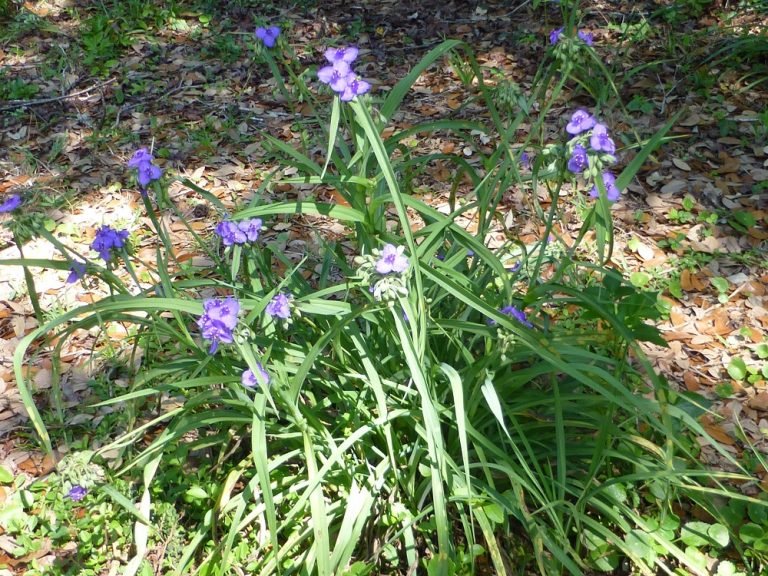
Latin Name: Tradescantia ohiensis
Common Names: Ohio spiderwort and bluejacket.
Family: It is in the Commelinaceae, or dayflower, family.
Form: This perennial wildflower grows to a height of about two feet and just about as wide.
Leaves: The leaves are linear with entire margins and are folded lengthwise. A gelatinous sap is released when they are cut.
Flowers: The blue flowers appear late winter, spring, summer and fall.
Habitat: It occurs naturally in moist ditches, moist meadows, riparian areas, and disturbed sites.
Native Range: It is native to the following states: AL, AR, CT, DE, FL, GA, IA, IL, IN, KS, KY, LA, MA, MD, ME, MI, MN, MO, MS, NC, NE, NH, NJ, NY, OH, OK, PA, RI, SC, TN, TX, VA, WI, and WV.
Landscape Use: In the home landscape it can be grown in full sun to part shade with average to moist soils. It flowers best in full sun.
Wildlife Uses: The flowers are a favorite of bees and it is a bumblebee favorite, and the seeds are eaten by songbirds.
Propagation: It can be grown with seeds or transplants. When transplanting remove any flowering stalks to help reduce the shock to the specimen.
Trichostema dichotomum
(Forked Bluecurls)
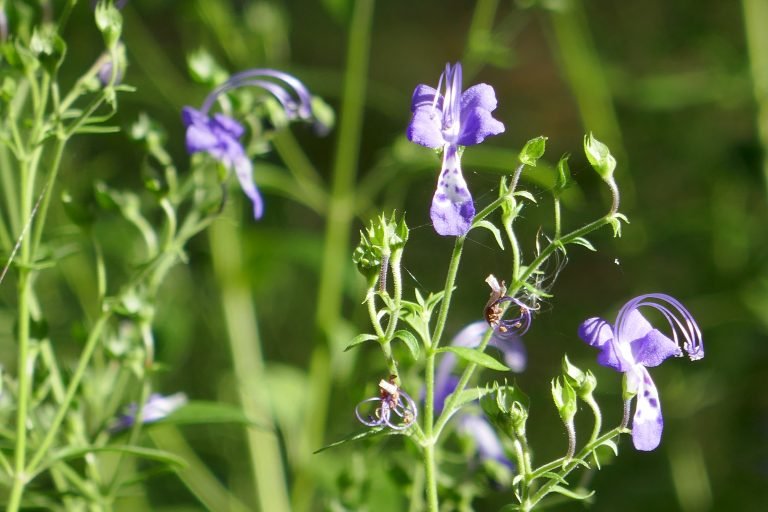
Latin Name: Trichostema dichotomum
Common Names: Forked bluecurls and bluecurls.
Family: It is in the Lamiaceae, or mint, family.
Form: A perennial wildflower that grows to a height of 3 feet tall.
Leaves: The leaves are opposite with entire or toothed margins and elliptic to lanceolate in shape.
Flowers: The brilliant blue flowers appear in the summer and fall.
Habitat: It occurs naturally in pinelands, sandhills, fields, and open forests.
Native Range: It is native to the southeastern United States and can be found from Florida north into Canada.
It is native to AL, AR, CT, DC, DE, FL, GA, IA, IL, IN, KY, LA, MA, MD, ME, MI, MO, MS, NC, NH, NJ, NY, OH, OK, PA, RI, SC, TN, TX, VA,VT, and WV.
Landscape Use: In the home landscape it grows in part shade with average to dry soils. Some literature lists it as an annual. However, in frost free areas it grows as a perennial.
Wildlife Uses: Bees and other small pollinators use the flowers for a source of nectar and pollen.
Propagation: It can be grown from seed or transplanted when small. Larger specimens can be transplanted if most of the upper foliage is removed and it is kept moist until new growth appears.
Here's a great book for looking up Florida wildflowers by their color!
Nurseries That Sell Florida Native Plants
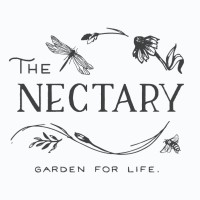
The Nectary
A native plant nursery that is open to the general public.
Thursday 11am-3pm
Fridays and Saturdays 9 am – 3 pm
They are located in Lakeland, Florida
1047 E. Main Street (863) 937-7879 TheNectaryLKLD@gmail.com
Use this link to get to Google Maps to show the location.
1047 E. Main St, Lakeland FL 33801

The Natives
A native plant nursery that is open to the general public.
Thursdays from 9 – 12.
They are located in Davenport, Florida.
2929 J. B. Carter Road 863-422-6664 natives@gate.net
Use this link to get to Google Maps to show the location.
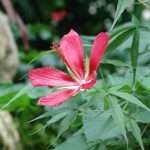
Mail Order Natives
We have provided native plants to wonderful people across the USA for 15 years. That is our mission! We also would like you to know our plants are NEVER collected from the wild. We grow all of our plants from seed or cuttings in our own facility. We will be adding extra plant selections over the next few months, so come back regularly. You can contact us at: 850-973-7371 (cell), 850-971-5416 (fax), and email: mailordernatives@gmail.com
A native plant nursery that ships plants through the mail.
They are located in Lee, Florida.
Their plants are the most gorgeous natives that I have ever purchased. Yes shipping can be expensive, but it is so worth it because of the quality of the plants. They also pack their orders with great care. I’ve been thrilled with every purchase and I’m sure you will be too.

Green Isle Gardens
Green Isle Gardens specializes in Florida native plants and wildflowers, with a focus on upland plant species. The nursery has 8 acres under production and features more than 150 species of native plants.
Our plants are grown without using pesticides with the goal of preserving nature, and all its critters, in mind. We encourage the use of pine straw mulch and offer bales for sale.
Green Isle Gardens is open to the public for retail sales.
Wednesday – Friday: 8am to 3:30pm
Saturday: 8am to 3pm
They are located in Groveland.
Green Isle Gardens Retail Plant List
Green Isle Gardens
11303 Florida 33
Groveland, FL 34736
Use this link to go to Google Maps to show the location:
